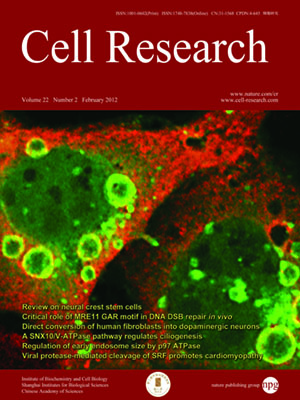
Volume 22, No 2, Feb 2012
ISSN: 1001-0602
EISSN: 1748-7838 2018
impact factor 17.848*
(Clarivate Analytics, 2019)
Volume 22 Issue 2, February 2012: 387-398
ORIGINAL ARTICLES
Serum inducible kinase is a positive regulator of cortical dendrite development and is required for BDNF-promoted dendritic arborization
Shun-Ling Guo1, Guo-He Tan1, Shuai Li1, Xue-Wen Cheng1, Ya Zhou2, Yun-Fang Jia1, Hui Xiong1, Jiong Tao2 and Zhi-Qi Xiong1
1Institute of Neuroscience and State Key Laboratory of Neuroscience, Shanghai Institutes for Biological Sciences, Chinese Academy of Sciences, Yueyang Road #320, ION building, Room 426, Shanghai 200031, China
2Xinhua Hospital, School of Medicine, Shanghai Jiao Tong University, Shanghai 200092, China
Correspondence: Zhi-Qi Xiong,(xiongzhiqi@ion.ac.cn)
Serum inducible kinase (SNK), also known as
polo-
like
kinase 2 (PLK2), is a known regulator of mitosis, synaptogenesis and synaptic homeostasis. However, its role in early cortical development is unknown. Herein, we show that
snk is expressed in the cortical plate from embryonic day 14, but not in the ventricular/subventricular zones (VZ/SVZ), and SNK protein localizes to the soma and dendrites of cultured immature cortical neurons. Loss of SNK impaired dendritic but not axonal arborization in a dose-dependent manner and overexpression had opposite effects, both
in vitro and
in vivo. Overexpression of SNK also caused abnormal branching of the leading process of migrating cortical neurons in electroporated cortices. The kinase activity was necessary for these effects. Extracellular signal-regulated kinase (ERK) pathway activity downstream of brain-derived neurotrophic factor (BDNF) stimulation led to increases in SNK protein expression via transcriptional regulation, and this upregulation was necessary for the growth-promoting effect of BDNF on dendritic arborization. Taken together, our results indicate that SNK is essential for dendrite morphogenesis in cortical neurons.
Cell Research (2012) 22:387-398. doi:10.1038/cr.2011.100; published online 21 June 2011
FULL TEXT | PDF
Browse 2049


